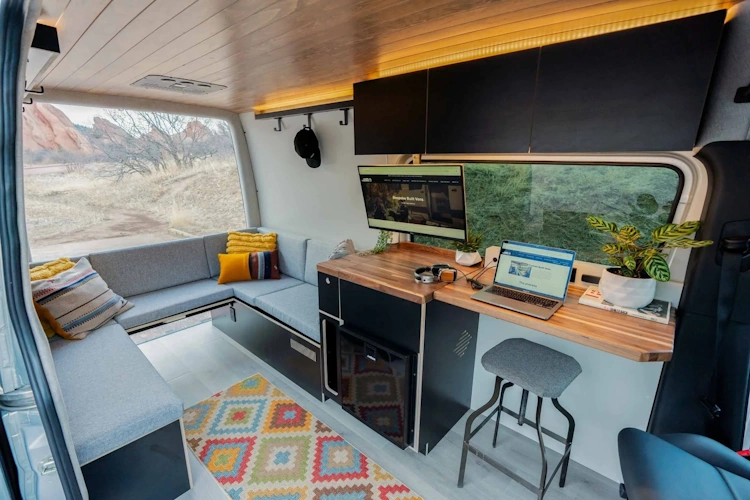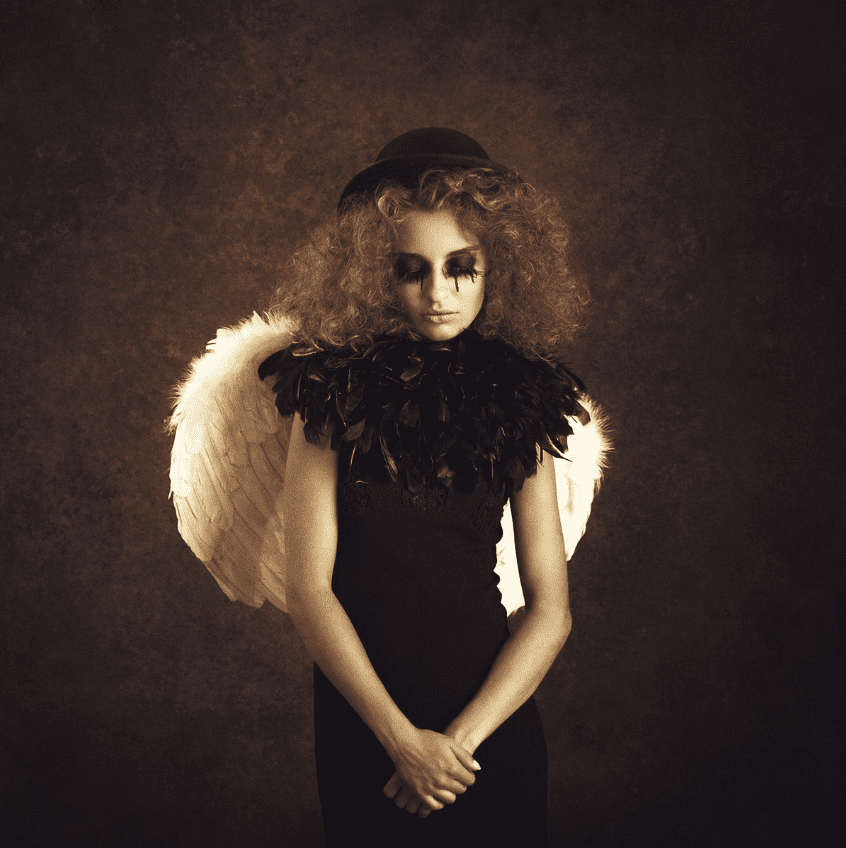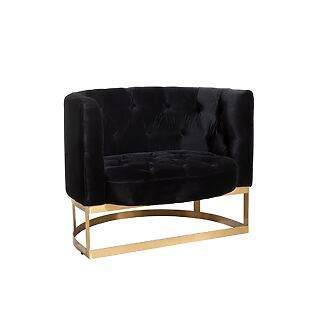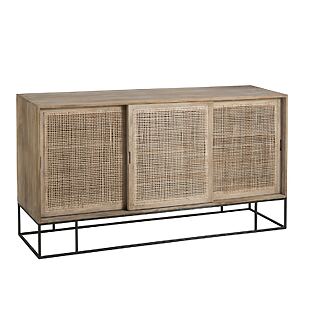A number of adventurous digital natives and creative souls have discovered camper van conversions as a new lifestyle choice: van life . These free spirits are leaving their traditional houses and apartments behind to experience the freedom of living on wheels. Since purchasing a new camper van is a considerable financial undertaking, used vans are often transformed into fully functional mobile homes, ready for all kinds of adventures, through professional camper van conversions. Numerous artists find this lifestyle appealing because it allows them to pursue their creative passions while traveling.
These converted vehicles are more than just means of transportation – they're transformed into complete living and working spaces in a compact footprint. Some passionate travelers have even made their DIY campervan conversions their permanent residences. London-based neo-pop artist Mia Hawk took a different approach, designing a campervan tailored to her artistic needs to support her digital nomad lifestyle. Her mobile workspaces showcase innovative layouts and clever kitchen designs with stunning interiors that make effective use of every inch.
See this post on Instagram
Creative individuals with DIY skills can transform a modest 91-square-foot interior into both a mobile home and an art studio. Mia Hawk's renovation project, also featured by Nate Murphy of Murphy Bed System , demonstrates that artists can express themselves regardless of space limitations.
Why the artist built a mobile studio van
The dream of creating a mobile art studio begins as a practical solution that evolves into something deeper. Many artists who transform their vehicles into creative workspaces experience a shift in the direction of their lives. This not only changes their workplace but also their entire approach to art production. Mia Hawk is not alone in this realization; there are numerous other examples of creatives on the road.
Combine travel with creativity
Artists who embrace a nomadic lifestyle learn that mobility adds a new depth to their creative process. Alaska-born painter LaMonte Lamoureux moved into his Sandy Van Sprinter camper van and saw his work completely transformed.
The opportunity to reach remote locations and experience the environment (light, composition, colors, etc.) inspires my artistic process,”
he explains.
See this post on Instagram
Travel and art naturally go hand in hand . New environments sharpen an artist's senses and help them notice subtle details they might overlook in familiar places. This fresh stimulation often sparks creative breakthroughs that a static environment cannot offer.
A mobile studio allows artists landscapes at their most magnificent moments. Artists can paint real scenes instead of working from photos or memories. They can immerse themselves in the precise light and atmosphere of their subject. As one artist aptly put it:
Travel is medicine, how it inspires and enlightens you.
A nomadic lifestyle helps artists overcome creative blocks that arise from routine. New environments force artists to adapt and try unfamiliar approaches. These shifts in perspective often lead to new ways of working.
Overcoming the limitations of a stationary studio
Traditional studios have built-in boundaries that mobile workspaces naturally overcome. A fixed studio ties artists to a specific location, limiting both inspiration and opportunities for growth. Artist Emilie Lee puts it this way:
When I moved to New York City to study painting, I constantly dreamed of returning to my simple life on the streets.
Permanent studios also present practical challenges. Alli Harvey initially conceived of her mobile art studio as "a Covid-19 adaptation following the closure of my stationary studio in 2020." The idea quickly evolved into something bigger—a way to "paint more" and gain "geographical mobility."
See this post on Instagram
Traditional studios require strict scheduling. Artists must book sessions and adhere to fixed times, which can limit spontaneous creativity. A mobile studio allows artists to react instantly when inspiration strikes – a crucial advantage for those who work instinctively and intuitively.
Traditional studios also keep artists away from nature. Many artists get their most inspiring ideas outdoors, but traditional studios separate them from these sources. A van conversion solution perfectly solves this problem by allowing artists to work directly in the landscapes that inspire them.
The costs of maintaining a permanent studio are driving many artists to mobile options. Mobile studios eliminate fixed costs and free up money for materials, travel, and other creative needs.
Building a mobile studio van is more than just a practical choice—it's about choosing a different lifestyle. It demonstrates that artists value freedom, inspiration, and growth more than convention and stability. As Alli Harvey says, her mobile studio came to "a turning point in the direction of my life" by allowing her to "drive directly to the landscapes I love to paint and connect with people along the way .
See this post on Instagram
Artists seeking to break free from creative boundaries will find that a well-designed van conversion perfectly balances mobility and function. It becomes a studio without walls, where the world serves as both canvas and inspiration.
Designing a camper van for an artistic lifestyle
Artists who convert vans into living spaces face unique challenges. They need both a comfortable home and a productive workspace. Smart planning helps maximize every inch of space to support creative work.

This image is for illustrative purposes and was created by us using AI.
Finding a balance between work and living space
Clever van layouts allow each space to serve multiple purposes. This approach is becoming vital for artists. A fold-out table serves as a workspace and can also be used as a dining table or laptop station. Such versatility makes even a small van surprisingly practical.
Storage solutions make a significant difference in this balance. Artists need ample space for materials, finished works, and equipment. Custom-made cabinets, specifically designed for artwork and materials, offer a practical solution. Aluminum profiles are a flexible and lightweight choice for customized storage solutions in vans and campers. This keeps essential items organized without cluttering the living space.
Some artists opt for a boot-jump setup , which extends the floor down to the footwell. A boot-jump campervan box is a prefabricated conversion kit that can be installed from the trunk. This design adds extra living and working space. Others incorporate pull-out storage cabinets and drawers that utilize vertical space while keeping items within easy reach.
The best designs reflect real-life usage patterns rather than theoretical plans. This includes space for dirty clothes, charging stations for devices, and daily routines that make van life comfortable.
Choose a layout that supports the painting.
The placement of a desk makes a significant difference for visual artists. An art table near large windows or doors allows natural light to fill the workspace. Many artists set up their workspace by back doors. This allows them to paint with the doors open or closed and still benefit from daylight.
Wet paintings require special storage solutions. Metal drawer systems, which can be adapted to different van models and personal needs using aluminum profiles, custom cuts, and appropriate connection technology, offer an excellent solution. They keep finished artworks secure during transport on rough roads. These drawers and shelving systems, made from structural profiles, prevent the paintings from touching each other and ensure air circulation so they can dry properly.
Easy access to materials determines how often artists use their mobile studio. Many artists design storage space within easy reach, creating special compartments for different materials.
- Watercolors, brushes and pencils in the luggage compartments above the seats.
- Larger materials and paper in the storage space under the bed
- Frequently used tools in easily accessible drawers near the workstation.
Optimal lighting helps artists to produce detailed work. Natural light is best, but bright, dimmable LED lights allow artists to work in all conditions. Track lighting (aluminum and structural profiles are also suitable for this) offers another option. It directs the light precisely where it is needed for different projects.
Using natural light for creative activities
Natural light transforms everything inside a van. It makes spaces appear larger and creates optimal conditions for artistic work. Sunlight also boosts mood and creativity, while reducing the feeling of confinement in compact spaces.
Windows are the easiest way to bring daylight , and their placement is crucial. Large side windows and back doors with glass panels flood the room with light. Windows also connect artists to the nearby landscapes, which are often their primary source of inspiration. The number of windows must be carefully planned, as glass affects interior temperatures.
Skylights offer another great option, especially for artists who want a more understated van exterior. Skylights brighten dark areas with light from above. Many artists consider skylights essential because they "flood the space with natural light" while also protecting against the elements.
Natural light doesn't just look good. It creates an airflow that helps regulate temperatures naturally. This reduces the need for fans and air conditioners and saves battery power for artistic tools and equipment.
Intelligent design choices help artists build mobile studios that support their creativity without sacrificing comfort. The result is a smart solution that enhances the creative experience.
The folding bed that changed everything
Finding the right bed configuration was the biggest challenge when Mia Hawk converted the van. The bed would determine how much workspace the artist had left for her art. This decision would shape the entire build.
Why a folding bed was the best choice
After exploring many options, she opted for a Murphy bed – the fold-down bed that transforms into a wall when not in use. This space-saving solution allows her to utilize the entire floor space during the day. Regular platform beds constantly take up space, but a Murphy bed opens up the entire van when folded away. The space feels surprisingly spacious.
The bed adjusts quickly, so switching from sleeping to art studio takes no time. The bed remains stowed away for about two-thirds of the day while the artist works, allowing her to utilize every inch of the van's interior.
From design to installation
Building a Murphy bed for a van is different from building one for a house. Its design had to withstand all the movement and shaking while driving without unexpectedly collapsing.
She used the Murphy system to build the frame primarily from wood, omitting complicated parts like bearings. This simpler design worked better for a moving vehicle. The bed platform uses 3/4-inch, 7-ply plywood—it cost about $50 per sheet, but the quality was worth every penny. This strong material required no additional support and remained light enough to lift.
The mounting system required careful planning, as it had to support a nearly 400-pound mattress and people without wobbling. Rails were used, connected on one side to the van's metal ribs and on the other to the cabinets.
The artist's custom design has another great feature – the platforms can be removed when moving bulky items. This flexibility has been a huge help to her while traveling. She can easily help friends move furniture or transport larger artworks to exhibitions.
A milling cutter helped create small recesses for the sliding slats so they wouldn't jam in the last few centimeters. This tiny detail makes it easier to use the bed extensively every day.
Safety and space-saving considerations
Safety was a top priority in the design process. Murphy beds can tip over if they are not installed correctly. The artist addressed this vulnerability by attaching the bed frame directly to the van's structure, not just to the wall panels.
The locking system ensures safety – it secures the bed so it doesn't fall out while driving. Mia tried several locks before finding one that stayed locked even on bumpy roads.
The weight must also be evenly distributed to protect the frame. The lifting mechanism uses balanced tension, making it easy to raise and lower the bed without compromising safety.
This fold-down bed has transformed the small van into two rooms that perfectly support Mia's artistic life. The open floor allows her to work on larger canvases , and at night she sleeps in a proper bed. This one breakthrough has changed how well she can live and work simultaneously in my mobile studio.
The path to a functional kitchen and water system
A well-designed kitchen transforms van life from simple camping into a comfortable home. Mia tackled the kitchen project immediately after finishing her mobile art studio and resolving her sleeping arrangements. The space had to meet both her cooking needs and her artistic lifestyle, while making the most of the limited square footage.
Cooking utensils for a mobile artist
A successful van kitchen requires multifunctional, lightweight, and durable tools that justify their space. Since an artist's work involves mixing paints and preparing materials, a kitchen suitable for both food preparation and artistic tasks is essential.
An induction cooktop proved to be the ideal choice. It doesn't heat up the kitchen like gas stoves, requires no complicated setup, and cleaning is a breeze. The cooktop also attracts far less attention than cooking outdoors, making it perfect for stealth camping in urban areas between art exhibitions.
Mia's essential cooking set includes:
- A high-quality pot with measuring lines on the side (no measuring cups needed)
- A sieve lid (instead of a bulky sieve)
- Baking trays that serve as additional work surface when placed over a cooking surface.
- A small pressure cooker for quick one-pot meals, saving time for creative work.
She added a mini air fryer , which is great for roasting vegetables, reheating leftovers, and toasting when she's busy at work beyond mealtimes.
Installation of a water tank and a pump
The water system makes all the difference between "van camping" and true "van life ." Research led to the decision to install a 25-gallon fresh water tank above the wheel arch. This placement improves handling by lowering the center of gravity while maximizing storage space.
Furthermore, a Shurflo Revolution diaphragm pump with the following specifications was selected:
- Cut-off pressure: 55 PSI
- Restart pressure: 40 PSI
- Flow rate: 3 gallons per minute
The pump maintains constant pressure and starts automatically when the taps are opened. It stops once the correct pressure is restored. An accumulator smooths the water supply and reduces the pump cycles, making the system feel more like a home plumbing system.
The greywater system uses a 5-gallon tank with quick Terms & Conditions release fittings that make emptying easy. This smaller size works well because not all the water goes down the drain.
PEX pipes were the best choice for the plumbing installation because they:
- withstand frost and high temperature fluctuations
- Offering flexibility for installation through narrow spaces
- Will not corrode over time
- Hot/cold lines are color-coded.
- Add an oven and maximize storage space.
Most van dwellers forgo stoves, but adding one has revolutionized Mia's mobile life. A compact propane stove has significantly expanded her cooking options—perfect for rainy days when cooking outdoors isn't possible. The stove fits under the cooktop in a custom-built cabinet that utilizes every inch of storage space.
Organizing storage space became a passion for Mia. A magnetic spice rack on the wall freed up space in the cupboard while keeping the spices within easy reach. Areas under the sink now have quick-access containers for cleaning supplies.
The best storage solution is a pull-out drawer system for pots and pans under the stove. The drawer can be fully extended, allowing access to items at the back without having to dig
To maximize the space on the work surface, the following measures were implemented:
- A sink cover that doubles as a cutting board
- Fold-out tables that provide additional workspace when needed.
- Strategic baseboards under cabinets for additional storage space
The kitchen uses lightweight yet durable materials that can withstand travel vibrations. After thousands of miles on the road, every cabinet remains sturdy and secure.
This kitchen design demonstrates that artistic living doesn't mean sacrificing practicality. The design process itself became a creative project, proving that functionality and creativity are great partners on the journey.
Implementing a shower and heating system on a small budget
The artist made installing a shower her next priority after months without proper bathroom facilities. Most van conversions forgo this comfort. However, a shower makes all the difference between occasional travel and genuine long-term living.
Why a shower became a necessity
The mobile studio became a full-time home for set periods, so Mia couldn't rely on campsite facilities or gym memberships indefinitely. A few days of plein air painting would leave her returning to the van covered in acrylic paint. This highlighted why an onboard bathroom had become necessary. Artists work in messy conditions that often require a quick clean-up, unlike weekend travelers.
A permanent shower takes up valuable space and resources. However, it allows artists to stay longer in inspiring remote locations without worrying about finding facilities or neglecting hygiene.
Use of wet room panels for sealing
The waterproof cladding turned out to be easier than expected. The decision was made in favor of wetwall panels instead of traditional tiles, which are laid without grout. Tongue-and-groove bathroom panels completely keep water out and offer several advantages:
- Faster installation than with conventional tile laying
- Scratch and impact resistant surface
- Integrated antimicrobial protection
The wooden frame was made waterproof with a sealing kit before the panels were installed. The process included a waterproof primer to seal the wood, waterproof tape for the corners, and a sealing membrane as a watertight barrier. This three-layer approach will provide complete protection for the van's structure.
The flooring chosen was a special wet room material known for its grip – an essential feature in such a small space.
A gas heater that doesn't use electricity
The power limitations presented unique challenges during the heating installation. Research led the artist to select a compact propane heater that operates efficiently without draining the batteries.
Propane heaters operate independently of the electrical system and use minimal power for ignition. They cost between $100 and $500, making them cheaper than diesel systems, which cost over $800.
The choice fell on the Malaga 5 , which provides 3.5 gallons of hot water when needed. The RV manufacturers designed it with safety features ideal for small spaces. The heater draws in outside air, combines it with propane, and vents the exhaust gases to the outside – thus preventing a dangerous build-up of carbon monoxide.
With this setup, Mia's mobile studio has truly become habitable. It shows that you can create comfort without spending huge sums of money – you just need thoughtful planning.
Powering the mobile studio: solar, batteries and lighting
A reliable power supply is the foundation of any mobile studio. It supports creative work and daily life. A well-planned electrical system transforms a van conversion from a " fancy tent on wheels" into a functional workspace.
Installation of solar panels and battery capacity
Mia's mobile studio has a 400-watt solar array with monocrystalline modules. These panels perform better than polycrystalline options, generating more energy on limited roof space. They were given a slight tilt to maximize sunlight exposure and allow water to run off easily. The setup connects to an MPPT charge controller, which makes charging up to 30% more efficient each day.
Choosing the right batteries made a significant difference. Lithium batteries cost more initially, but offer better value for money in the long run. They weigh less, have more power, and last longer than conventional AGM batteries.
Lighting for both ambience and work
LED lights have completely transformed the van's interior. They save energy and consume very little battery power. A 16-foot LED strip has 300 LEDs and draws only 3.3 amps at full brightness.
The van was fitted with two lighting systems. Bright task lights illuminate the workspace for detailed art, while soft ambient lights create a cozy atmosphere in the evenings. This setup helps separate work from rest periods, even in the smallest of spaces.
Power management on cloudy days
Cloudy weather initially put the power supply to the test. The 400-watt array produces between 40 and 100 watts when heavy clouds gather. Here, one has to learn to use only essential equipment, charge devices during peak hours (10 a.m. to 2 p.m.), and sometimes drive to higher elevations where solar panels perform better.
A tr Terms & Conditions arer emergency generator with a power output of 2,000–3,000 watts can handle extended periods of cloud cover. This power output is well suited for most van setups.
Final words
A standard van transformed into a mobile art studio is more than just a clever use of space—it transforms an artist's connection to creativity. The fold-out Murphy bed design is a groundbreaking element that doubles the usable area with a simple daily switch. This feature allows artists to work on larger canvases without sacrificing sleeping comfort.
Intelligent kitchen systems demonstrate that artistic living doesn't mean sacrificing practical conveniences. Water systems with custom-fit tanks elevate true van life beyond simple camping, and compact showers eliminate the need to search for facilities.
Energy management is perhaps the backbone of any successful mobile studio. A well-designed solar system, combined with efficient lithium batteries, powers both creative work and daily needs.
Artists considering van life should know that successful conversions prioritize multifunctionality over compromise. Each component serves multiple purposes while using minimal resources. While challenging, the rewards of artistic mobility extend far beyond the reach and impact of practicality—they revolutionize the creative process.
The mobile studio lifestyle ultimately gives nomadic artists something traditional spaces cannot: direct immersion in their subjects. Artists create while physically present in inspiring landscapes, rather than working from photographs or memories. This immediate connection to the environment sparks creative breakthroughs that static studios cannot achieve.
Freedom requires thoughtful planning. Every system—from fold-out beds to solar panels—needs careful consideration of real-life usage patterns. But artists who incorporate this thought in advance gain something priceless: a boundless studio where the world becomes both canvas and inspiration.

Owner and Managing Director of Kunstplaza. Journalist, editor, and passionate blogger in the field of art, design, and creativity since 2011. Successful completion of a degree in web design as part of a university study (2008). Further development of creativity techniques through courses in free drawing, expressive painting, and theatre/acting. Profound knowledge of the art market through years of journalistic research and numerous collaborations with actors/institutions from art and culture.

















